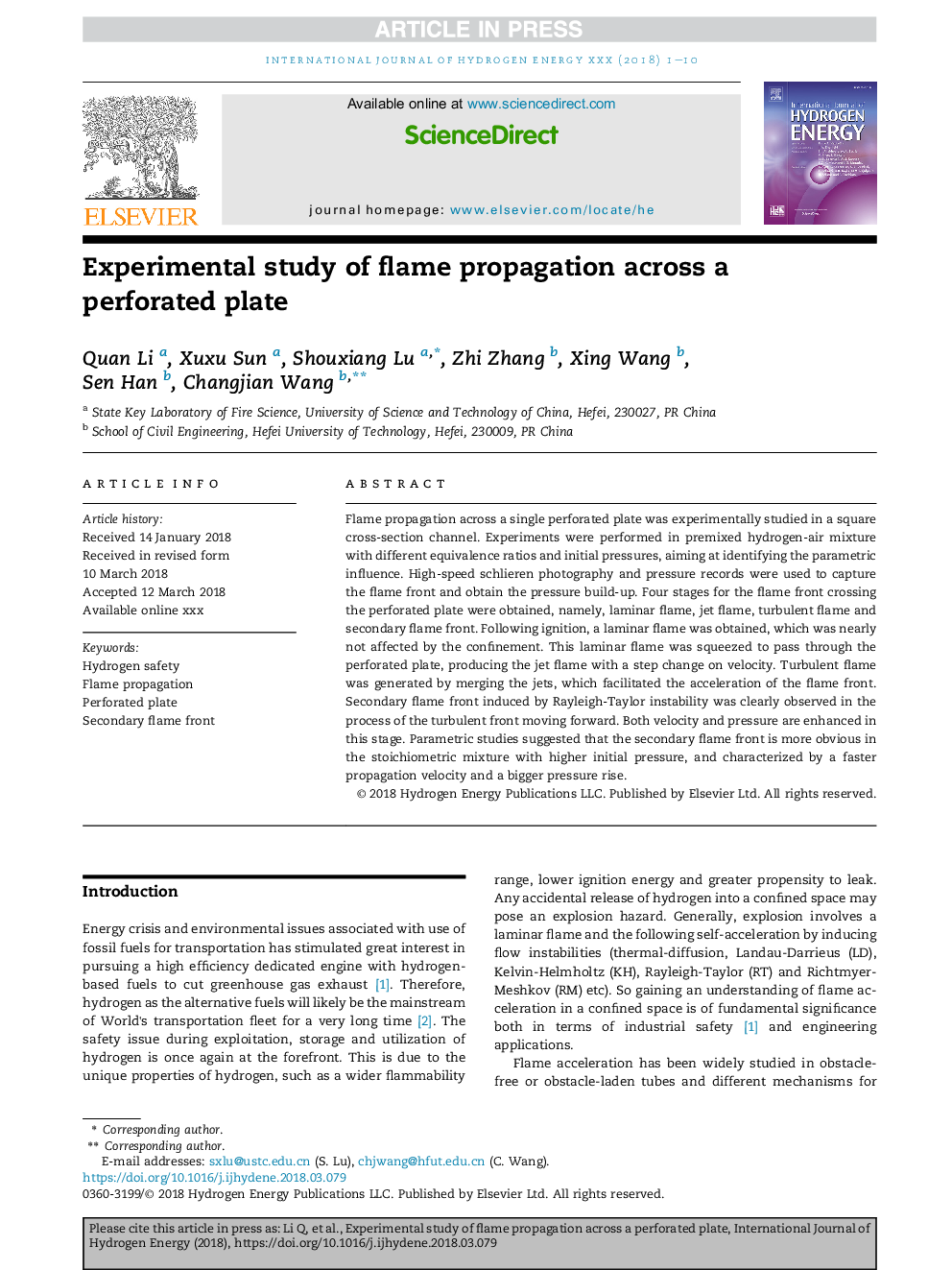| کد مقاله | کد نشریه | سال انتشار | مقاله انگلیسی | نسخه تمام متن |
|---|---|---|---|---|
| 7706325 | 1497308 | 2018 | 10 صفحه PDF | دانلود رایگان |
عنوان انگلیسی مقاله ISI
Experimental study of flame propagation across a perforated plate
ترجمه فارسی عنوان
بررسی تجربی انتشار شعله در یک ورق سوراخدار
دانلود مقاله + سفارش ترجمه
دانلود مقاله ISI انگلیسی
رایگان برای ایرانیان
کلمات کلیدی
ایمنی هیدروژن انتشار شعله، ورق سوراخدار جلو شعله دوم،
ترجمه چکیده
انتشار شعله در یک ورق تک نفوذ شده به صورت آزمایشی در یک کانال مقطع مربعی مورد مطالعه قرار گرفت. آزمایش ها در مخلوط مخلوط هیدروژن و هوا با مخلوط با نسبت های مشابه و فشار اولیه انجام شده است، با هدف شناسایی تاثیر پارامتری. عکسبرداری با سرعت بالا و سوابق فشار برای جلوگیری از شعله و به دست آوردن فشار ایجاد شده بود. چهار مرحله برای جلوگیری از شعله شعاع عبور از ورق سوراخ شده به دست آمده، یعنی شعله لامینار، شعله جت، شعله آشفته و جلوی شعله ثانویه. پس از احتراق، یک شعله لامینار به دست آمد که تقریبا تحت تاثیر قرار نداشت. این شعله لامینار برای عبور از ورق سوراخدار، فشرده شده و شعله جت را با تغییر گام در سرعت، تولید می کند. شعله آشفته از طریق ادغام جت ها تولید شده است، که باعث تسریع در برابر شعله می شود. ناشی از شعله دوم ثانویه ناشی از بی ثباتی ریلی تیلور در فرآیند جبهه متلاطم به جلو حرکت می کند. هر دو سرعت و فشار در این مرحله افزایش می یابد. مطالعات پارامتریک نشان می دهد که شعاع ثانویه در مخلوط استویومتریک با فشار اولیه بالاتر آشکارتر است و با سرعت انتشار سریعتر و افزایش فشار بیشتر مشخص می شود.
موضوعات مرتبط
مهندسی و علوم پایه
شیمی
الکتروشیمی
چکیده انگلیسی
Flame propagation across a single perforated plate was experimentally studied in a square cross-section channel. Experiments were performed in premixed hydrogen-air mixture with different equivalence ratios and initial pressures, aiming at identifying the parametric influence. High-speed schlieren photography and pressure records were used to capture the flame front and obtain the pressure build-up. Four stages for the flame front crossing the perforated plate were obtained, namely, laminar flame, jet flame, turbulent flame and secondary flame front. Following ignition, a laminar flame was obtained, which was nearly not affected by the confinement. This laminar flame was squeezed to pass through the perforated plate, producing the jet flame with a step change on velocity. Turbulent flame was generated by merging the jets, which facilitated the acceleration of the flame front. Secondary flame front induced by Rayleigh-Taylor instability was clearly observed in the process of the turbulent front moving forward. Both velocity and pressure are enhanced in this stage. Parametric studies suggested that the secondary flame front is more obvious in the stoichiometric mixture with higher initial pressure, and characterized by a faster propagation velocity and a bigger pressure rise.
ناشر
Database: Elsevier - ScienceDirect (ساینس دایرکت)
Journal: International Journal of Hydrogen Energy - Volume 43, Issue 17, 26 April 2018, Pages 8524-8533
Journal: International Journal of Hydrogen Energy - Volume 43, Issue 17, 26 April 2018, Pages 8524-8533
نویسندگان
Quan Li, Xuxu Sun, Shouxiang Lu, Zhi Zhang, Xing Wang, Sen Han, Changjian Wang,
